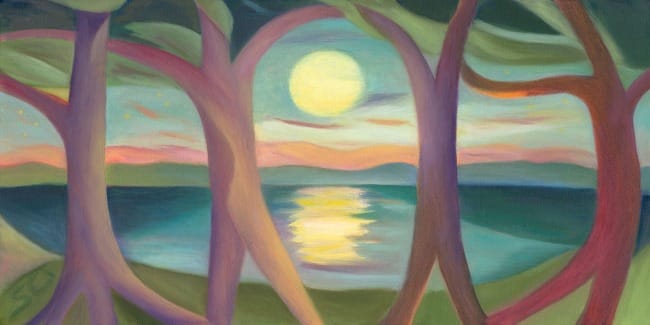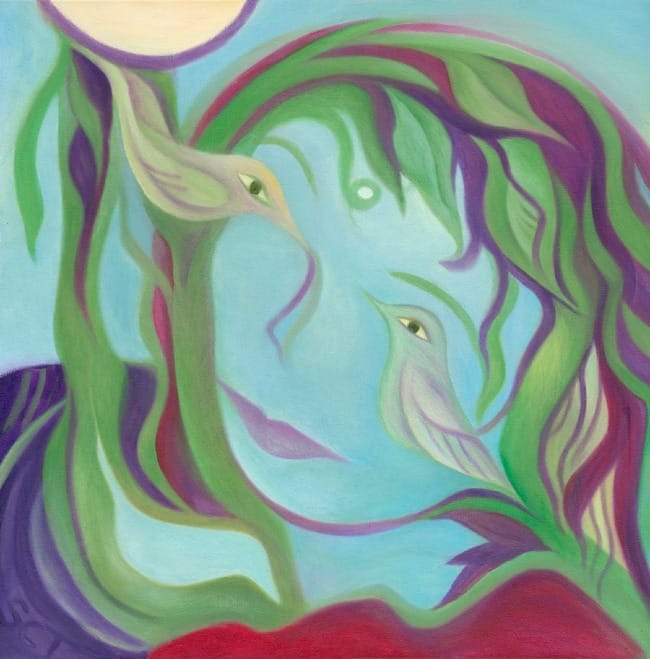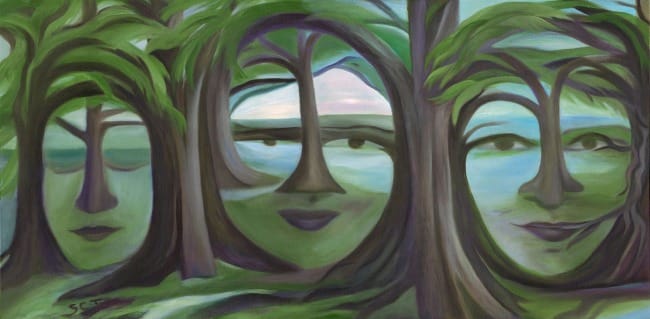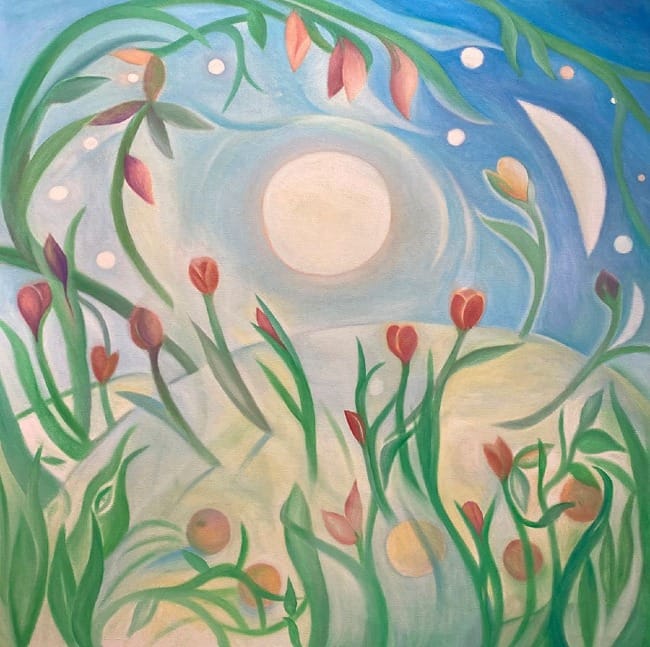Circlewood friend and guest writer Elaine Breckenridge shares the work of Camano Island artist and neighbor Susan Cohen Thompson. Along with the art itself, Elaine shares how it has influenced her own understanding of the world around her.
Readers of this blog may know that Camano Island, Washington is the home of the emerging Circlewood Village. It also happens to be home for many artists and their studios. Recently I had the privilege of touring the home and studios of Susan Cohen Thompson who lives only two miles from the Circlewood property.
The home of Susan and Clay Thompson shelters two working studios. Coming into their living space is like entering a display gallery. Paintings and drawings cover the walls and a variety of ceramics and artifacts line shelves and table tops throughout the main floor. Climbing the stairwell to the second floor took time, as I admired all the paintings on the way to the formal upstairs studio.
Walking into that space felt like stepping into a tree house. Large windows revealed a variety of deciduous and evergreen trees in the forestland of the adjacent Camano Island State Park. Through another window was a panoramic view of the Saratoga Passage, part of the Salish Sea with views of Whidbey Island and the Olympic Mountains. Returning my eyes to the walls in the studio, I gazed upon painting after painting of the natural world. In the tree house studio, the art of nature and the art of a human being merged seamlessly into one another. It is no wonder that Susan describes her art in this way:
To be human
I recognize my relationship with nature.
I see with the eyes of the trees
and feel with the heart of the forest.
—SCT

A favorite theme that can be seen in her art depicts trees not simply swaying in the wind, but dancing! Because Susan understands that trees and forests are sentient beings, she portrays them as dynamic and animated creatures. She believes that trees are the most generous and sacred beings on Earth. They provide countless species with food, shelter, warmth, water and perhaps most importantly—air. Trees breathe. Plants, animals and humans breathe. There is one breath on Earth. Susan has written, “I breathe the trees and the trees breathe me.”
Susan once had a dream when a thousand birds flew out of her hands and traveled around the globe whispering, “Everything is connected. You are a part of a feeling Earth.” Birds have been a favorite theme in all of her art forms since that dream. She loves to embed the general shape of birds into many of her paintings. Sometimes they become visible only after gazing deeply into the art work. Other times they make a vivid statement about interconnectivity.
In my dream of earth,
eye of self merges with eye of bird and
I am forever changed.
My primary self resides in nature.
—SCT

Besides her dream, Susan’s passion for understanding the significance of the interconnectedness of nature and humanity evolved out of her own lived experience. She has hiked into the temperate forests of the Pacific Northwest and deep into the rainforest of the Ecuadorian Amazon. Susan believes that our lack of appropriate relationships with nature stems from our lack of awareness of the deep connection that we human beings share with the Earth.
For me, this theme of the interconnectivity of life is the most moving and important aspect of Susan’s art. Her art embodies a central teaching of the contemplative monk and Christian mystic, Thomas Merton, who wrote of his “keen awareness of the interdependence of all living things which are all part of one another and involved in one another.”
In order to live as an ecological disciple, I believe that it is vital to understand our interdependence with all of Earth and her creatures. Once we realize that the Earth is indeed sacred, that the Earth does not belong to us, but that we belong to Earth, we begin to cultivate an expanding compassion for all of created life. We make healthier decisions for our own bodies and Earth’s body.
In my own spiritual journey, retirement from full time congregational ministry and relocation to Camano Island has been a life-transformative experience. My eyes were opened to the innate sacredness of the Earth when I began praying and worshipping outdoors. Additionally, experiencing the artwork created by Susan has led me to a deep awareness of the empathy I share with creation.
Showing that human beings are an integral part of nature is a recurring theme in Susan’s art. Her paintings emphasize what human beings might look like when they are fully connected to the Earth, which can be seen in the work below.

What do you see and experience happening as you pray with this painting? Obviously, we see immediately an image of a woman who is asleep. Resting, she appears content as her head is cradled in the arms of what appear to be two trees. As our eyes move from left to right in each image, her face becomes more defined. Her eyes are opening and developing in the middle frame and a more apparent smile is forming. At the same time, the image of the woman has also become more “nature-like” as images of water, sky and clouds are forming within her face. However, a naiveté remains in the expression of her eyes.
In the third frame we see a woman who is more fully formed and more obviously awake. I see a compassionate and wise gaze. Also, the woman’s humanity has become more embedded within the structure of what now appears to be a forest. The smaller tree that once cradled her face is now revealed with a more mature and sturdy trunk. A root wisp touches the woman’s mouth. The eyes appear to be more human looking. As for the nose, it too has become more humanlike. Or not. Perhaps the nose has become treelike. Perhaps they have become one. Yes! Human beings and trees share the same breath. While it is clear that the awakening woman is becoming more clearly defined against the backdrop of forest, sky and water; nature has been undergoing its own changes. The forest itself has become more expansive.
We often think and speak of the conflict and competition that exists between creation and humanity. Susan’s art is refreshing in that it clearly depicts how both can enhance one another. Her art gives us images which lead us into a deeper appreciation of both God’s creation and humanity by reminding us that we are dependent upon one another for our mutual individuation and evolution. It invites us to understand the point of view of nature instead of only focusing on our experiences in nature.
And, of course, her art is an invitation to be aware of our impact on the Earth. As creation theologian Matthew Fox has said, “Compassion is born of interconnectivity, the cosmic law of responding to another’s pain and suffering, joy and celebration as one’s own.”
What might happen if more of us had our own awakening and began to view life with the eyes of nature? Might that not enable us to cultivate a more robust mutual relationship with Earth? What might happen if we attuned ourselves to hearing what messages, what feelings, what wisdom is being offered to us by and through creation? Might we become more empathetic and compassionate human beings? I am thankful that Susan’s art invites us into this sacred dance with creation and all of its gifts and treasures.

Rev. Elaine Breckenridge
More of Susan’s work can be seen on her website.
Visit her Camano Island studio by appointment by emailing her at susan@thompsonartstudio.com, or calling 425-750-4994.
